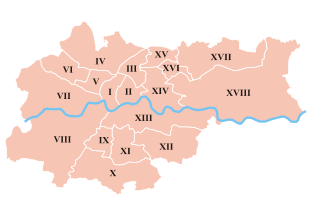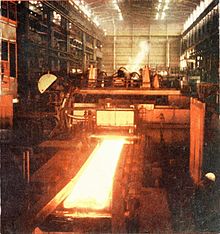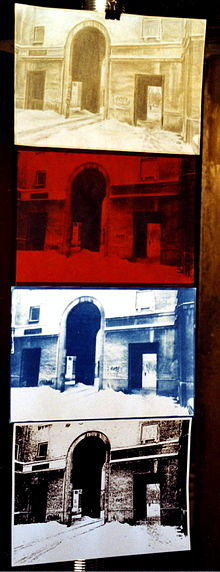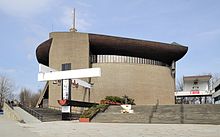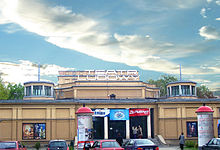- Nowa Huta
-
For other places with the same name, see Nowa Huta (disambiguation).
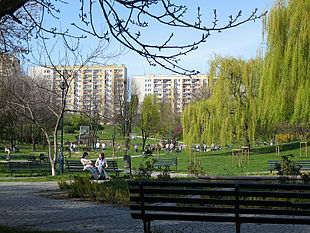 Park Tysiąclecia ("Park of the Millennium") housing estate.[1]
Park Tysiąclecia ("Park of the Millennium") housing estate.[1]
Nowa Huta (Polish pronunciation: [ˈnɔva ˈxuta], literally The New Steel Mill) - is the easternmost district of Kraków, Poland, (District XVIII, see map). With more than 200,000 inhabitants it is one of the most populous areas of the city.
Contents
History
The historic area of present-day Nowa Huta is one of the few places in Poland settled continuously since neolithic times. Archeological research has discovered a big Celtic settlement and Poland's oldest Slavic settlements there. A mound was erected by Vistulans in the 8th century. According to legend, the Wanda Mound is a tomb of Wanda, daughter of Krak, a mythical founder of Kraków. In the 13th century a Cistercian monastery in the village of Mogiła was built.[2][3]
In the 19th century and in the beginning of 20th century up to the First World War the outskirts of Nowa Huta constituted a border between Austria and Russia. One can find Austro-Hungarian forts there and one of Europe's oldest permanent airfields (Kraków-Rakowice-Czyżyny Airport, currently housing the Polish Aviation Museum).
Following the establishing of the People's Republic of Poland in 1945, the Communist authorities had encountered substantial resistance to their new regime from middle-class Cracovians. A referendum held by the authorities was soundly defeated by the people of Kraków - a major cause of embarrassment for the Government. To "correct the class imbalance", the authorities commenced building a satellite industrial town to attract people from lower socioeconomic backgrounds to the region, such as peasants and the working class.[2]
Nowa Huta was started in 1949 as a separate town near Kraków on terrain resumed by the Communist Government from former villages of Mogiła, Pleszów and Krzesławice. It was planned as a huge centre of heavy industry. The town was to become an ideal town for the communist propaganda and populated mostly by industrial workers. In 1951 it was joined with Kraków as its new district and the following year tramway communication was started.[2]
On July 22, 1954 the Vladimir Lenin Steelworks was opened and in less than 20 years the factory became the biggest steel mill in Poland. In the 1960s the city grew rapidly. The monumental architecture of the Central Square (Plac Centralny) was surrounded by huge blocks of flats. In the 1970s the steel production reached 7 millions tonnes of steel yearly. At the same time the biggest tobacco factory in Poland was opened there and a huge cement factory.
The reasons for building such an industrial town near Kraków were mostly ideological and were against laws of economy (coal had to be transported from Silesia and iron ore from the Soviet Union; the products were shipped to other parts of Poland since local demand was relatively small). This became visible in the 1980s, when the economic crisis halted the city's growth.
One type of building lacking from the original urban design of Nowa Huta was a Roman Catholic church. The public campaign to construct it lasted several years. As early as 1960, inhabitants of Nowa Huta began applying for permit to build a church. In that year, violent street fights with riot-police erupted over a wooden cross, erected without a permit. The locals were supported by Bishop Karol Wojtyla and eventually, a church called the Lord's Arc was built. The complex was consecrated by Wojtyla in 1977.[4] Wojtyla himself, after being elected Pope in 1978, wanted to visit Nowa Huta during his first papal pilgrimage in 1979, but was not permitted to do so.
In the 1980s Nowa Huta became a place of many demonstrations and violent street protests of the Solidarity movement, fought by the police. At that time, almost 29,000 of the 38,000 workers of the then Lenin's Steelworks belonged to the Trade Union "Solidarity".[5]
Architecture
Before 1956 (Socialist Realism)
 Architecture of Nowa Huta central runabout (Aleja Róż, 2003)
Architecture of Nowa Huta central runabout (Aleja Róż, 2003)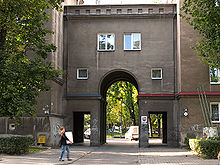 One of the gates of Szkolne housing estate.[6]
One of the gates of Szkolne housing estate.[6]
The doctrine of socialist realism in Poland, as in other countries of the People's Republics, was enforced from 1949 to 1956. It involved all domains of art, but its most spectacular achievements were made in the field of architecture. The main lines of this new trend were very precisely indicated in a 1949 resolution of the National Council of Party Architects. Architecture was an extremely important weapon to the creators of a new social order. It was intended to help to form a socialist theme - the ideas sparking citizens' consciousness and outlook on life. During this great work, a crucial role fell to an architect who wasn't perceived as merely an engineer creating streets and edifices, but an "engineer of the human soul". The general outlook of a building was more valued than its simple aesthetics. It needed to express social ideas, to arouse a feeling of persistence and power.
Since the style of the Renaissance was generally regarded as the most revered in old Polish architecture, it was to become also Poland's socialist national format. However, in the course of incorporating the principles of socialist realism, there were quite a few deviations introduced. One of these was to more closely reflect Soviet architecture, which resulted in the majority of works blending into one another; and finally the general acceptance of the classicist form. From 1953, critical opinions were increasingly frequently heard, and the doctrine was finally given up in 1956. Currently the socrealist city centre is considered a monument of architecture.
After 1956
Following political liberalization of the Polish October in 1956 it became possible to introduce modernist style in architecture. Polish architects were allowed to visit Stockholm to learn about newest solutions in urban design. As the result, the so-called "Swedish" apartment block was developed according to Le Corbusier guidelines. Among other buildings from that era, Światowid cinema is worth noting. In the 1980s first postmodernist buildings were built (Centrum E housing estate). In 1970s and 1980s most blocks of flats were built using plattenbau.
Nowa Huta's central avenue featured a countrywide known statue of Vladimir Lenin that was pulled down in 1989 by anti-revolutionary forces.[7]
Also sacral architecture should be noted, especially Arka Pana (Lord's Ark) church, which was built to resemble Noah's Ark. It was designed by the architects Wojciech Pietrzyk and Jan Grabacki, with the design being influenced by Le Corbusier's Notre Dame du Haut in Ronchamp.[8]
Nowa Huta Today
Since the fall of Communism the city that was once a showpiece for Stalinism now boasts many tributes to ardent anti-Communists. Streets formerly named after Lenin and the Cuban Revolution have been renamed to honor Pope John Paul II and the Polish exile leader Władysław Anders. In 2004 Plac Centralny, Nowa Huta's central square which once was home to a giant statue of Lenin - on display at High Chaparral Museum in Hillerstorp, Sweden, was renamed Ronald Reagan Central Square (Plac Centralny im. Ronalda Reagana) in honor of the former U.S. President.[9][10] However, this decision led to many protests,[11][12] and the traditional name is still widely used.
Landmarks
- Wanda Mound (Polish: Kopiec Wandy), (8th century)
- Cistercian abbey in Mogiła (1225)
- Jan Matejko manor in Krzesławice
- Branice manor
- St. Wenceslaus Church (1226)
- St. Bartholomew Church (1466)
- Austro-Hungarian forts: Batowice, Mistrzejowice, Dłubnia, Krzesławice, Grębałów, Mogiła
- Tadeusz Sendzimir Steel Mill (formerly Vladimir Lenin Steel Works)
- Plac Centralny, and Aleja Róż (Avenue of Roses) architecture
- Arka Pana (Lord's Ark) church and Chapel of Conciliation in Bieńczyce
- Polish Aviation Museum in Czyżyny
- Branch of the Historical Museum of Kraków, History of Nowa Huta[13]
Cultural significance
The Andrzej Wajda film, Man of Marble (Polish: Człowiek z marmuru), is based in Nowa Huta and chronicles the life of a bricklayer who helps build the new model socialist city. Man of Marble, made in the mid 1970s, presaged the Solidarity labor union movement in Gdańsk that was ultimately responsible for overthrowing Communism, as the film that starts in Nowa Huta ends in Gdańsk.
Widely promoted popular songs in 1950s, when the district was built, included "O Nowej to Hucie piosenka" (This Song is about Nowa Huta) featured here with the video. The song is still well remembered by many Poles especially of the older generation.
The Presumed Miracle, or Krakovians and Highlanders (Polish: Cud mniemany, czyli Krakowiacy i Górale) by Wojciech Bogusławski, Poland's first-ever opera[1] written in 1794 is set in the village of Mogiła, in the territory where Nowa Huta was built. Housing estates osiedle Krakowiaków (The Krakovians Estate) and osiedle Górali (The Highlanders Estate) are named after characters of the play. It was also the first drama played upon opening the Ludowy Theatre.[14]
Oedipus - a tragedy from Nowa Huta is a play based on ancient Greek myth about Oedipus, premiered in Łaźnia Nowa Theatre under direction of Bartosz Szydłowski[15]
In 2004 Austrian artist Tassilo Blittersdorff interpreted and variated photos of the socialist architecture and the interaction of the inhabitants with the buildings (pictured).
Venues
- Teatr Ludowy (The People's Theatre), Nowa Huta's oldest theatre[16][17]
- Łaźnia Nowa Theatre[18]
- Sfinks art-house cinema[19]
- The Nowa Huta Cultural Centre[20]
- The Cyprian Norwid Cultural Centre[21]
Industry
- Tadeusz Sendzimir Steel Mill (Polish: Huta im. Tadeusza Sendzimira) owned by Mittal Steel Company
- Kraków Power Station (Polish: Elektrociepłownia Kraków)
- Philip Morris Cigarettes Co.
- ComArch, an international software house
- INTERIA.PL, a company operating Poland's third biggest portal
Education
- Faculty of Mechanical Engineering, Cracow University of Technology
- Academy of Physical Education
See also
- Głos – Tygodnik Nowohucki
- Kraków
- History of Kraków
- Eisenhüttenstadt
- Magnitogorsk
Notes and references
- ^ Park Tysiąclecia, more photographs.
- ^ a b c Jerzy Aleksander Karnasiewicz, Nowa Huta. Okruchy życia i meandry historii (English: Nowa Huta. Crumbs of Life and the Meanders of History), photo anthology; Wydawnictwo Towarzystwo Slowaków w Polsce, Kraków, 2003; ISBN 83-89186-67-5
- ^ Cistercian monastery in Mogiła webpage
- ^ History of Nowa Huta, Gates of Lesser Poland informational portal
- ^ Nowa Huta, "Ciekawe miejsca" at www.60nh.pl
- ^ Szkolne housing estate, more photographs
- ^ UPHEAVAL IN THE EAST; Lenin Statue in Mothballs, The New York Times, December 11, 1989
- ^ Sacred buildings: a design manual By Rudolf Stegers, page 120, ISBN 9783764366834
- ^ "A Day Out in Lenin Land" at cracow-life.com
- ^ Related story at www.expatica.com
- ^ Related story at www.nowahuta.org.pl
- ^ Related story at www.zyciekrakowa.pl
- ^ Nowa Huta Branch of the Historical Museum of Kraków at www.mhk.pl
- ^ The Ludowy Theatre at www.krakow.pl
- ^ Łaźnia Nowa Theatre homepage
- ^ Related story at www.krakow.pl
- ^ Teatr Ludowy at www.cracow-life.com
- ^ Łaźnia Nowa Theatre homepage
- ^ Sfinks art-house cinema homepage
- ^ Nowa Huta Cultural Centre at www.krakow.pl
- ^ The Cyprian Norwid Cultural Centre at www.okn.edu.pl
- Nowa Huta Tourist Route, from the city's official website
- Nowa Huta, A Communist Paradise
- (English) (German) (Polish) Mindmapping Nowa Huta, student workshop
- (English) (German) (Polish) NH Reportage, photos
- (Polish) Nowa Huta internet portal
- Arka Pana, Catholicism Comes to Nowa Huta
- (Polish) Nowa Huta daily news
- (English) Poems by Immanuel Mifsud about Poland including two about Nowa Huta
- (Polish) Nowa Huta Fotodocumentation (architecture + interactive map)
- Satellite photo of Nowa Huta centre
- Satellite photo of the steelworks
Kraków Districts Stare Miasto (I) · Grzegórzki (II) · Prądnik Czerwony (III) · Prądnik Biały (IV) · Krowodrza (V) · Bronowice (VI) · Zwierzyniec (VII) · Dębniki (VIII) · Łagiewniki-Borek Fałęcki (IX) · Swoszowice (X) · Podgórze Duchackie (XI) · Podgórze Duchackie (XII) · Podgórze (XIII) · Czyżyny (XIV) · Mistrzejowice (XV) · Bieńczyce (XVI) · Wzgórza Krzesławickie (XVII) · and Nowa Huta (XVIII)
Neighborhoods: Wawel · Kleparz · Kazimierz · Bielany
Attractions Museums Categories:- Socialist planned cities
- Districts of Kraków
- Planned cities in Poland
Wikimedia Foundation. 2010.

